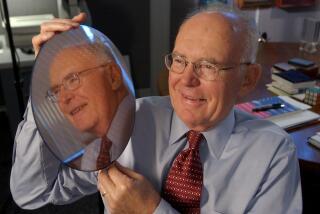Supercomputer Genius Hits Snag : Famed Designer Cray Sees His Firm File for Chapter 11
- Share via
SAN FRANCISCO — In what is perhaps the coda to the career of one of America’s most brilliant inventors, Cray Computer Corp., the third company to be started by famed supercomputer designer Seymour Cray, filed for Chapter 11 bankruptcy on Friday.
Founded in 1989 after Cray resigned from one of his earlier companies, Cray Research Inc., Cray Computer spent more than $200 million trying to build and market an innovative computer many times more powerful than anything that existed before.
Supercomputers are the Ferraris of computing, tackling the most complex problems like weather forecasting, earthquake simulations and molecular modeling--and for decades the fastest ones were always designed by Seymour Cray.
But his latest machine was extraordinarily expensive, the alternatives had grown very cheap, and a slimmed-down Pentagon had lost its appetite for experimental supercomputers. Indeed, two other supercomputer vendors have filed Chapter 11 bankruptcy recently.
Cray Computer, which has suffered financial problems for several years, had hopes for a new cash infusion as recently as last week, but a pending deal to bring in $20 million in equity financing fell through.
“The investors had been lined up, but we fell short of the amount we needed,” said Charles Breckenridge, Cray Computer marketing vice president and a Seymour Cray associate since 1959. “We came close. We really don’t know why it didn’t happen.”
In a petition filed with the U.S. Bankruptcy Court in Denver, Cray listed debts of $18.8 million and assets of $22.9 million. The company has ceased operations, and 300 employees at the firm’s facilities in Colorado Springs have been laid off.
Even if it had overcome the latest cash crisis, even many of Seymour Cray’s biggest supporters questioned whether Cray Computer could ever have reached the point of self-sufficiency.
Cray, 69, is an eccentric who once set fire to a sailboat he had designed and built because he was designing another one and didn’t want to replicate his earlier work. He brought the same philosophy to supercomputer design. “He was always talking about starting with a blank piece of paper,” Breckenridge said.
That worked splendidly for many years. Cray invented the first supercomputer at Control Data Corp., a company he co-founded in the mid-1950s. He went on to perfect his designs at Cray Research, the company he started in 1976. In the early 1980s, he began work on a daring machine that would use computer circuits made from fast but unstable gallium arsenide.
The board of publicly traded Cray Research decided that its founder’s plan was too risky, and Cray Computing was spun out with a $100-million investment from Cray Research. But the components proved extremely expensive to manufacture, and the market for a machine costing tens of millions of dollars was tiny indeed.
When Lawrence Livermore backed out of a deal to buy the first of the new Crays in 1991, the company’s fate began to look very uncertain. Cray Computing wound up with one machine too expensive to be practical, and another, with a less ambitious design, remaining unfinished. It was Seymour Cray’s insistence on pushing the technological envelope that helped sink his venture.
“It’s tragic,” said Gordon Bell, the legendary designer of Digital Equipment Corp.’s VAX minicomputer. “Once you go off the beaten path, you have no guides. There’s no one to help you. You have to make all the inventions yourself and fund them yourself.”
And the basic Cray approach--based on very, very fast, highly customized processors--is now being displaced by designs which harness hundreds or even thousands of cheap, off-the-shelf microprocessors. Meanwhile, many business customers are opting for “minisupercomputers” and engineering workstations which can handle all but the most complex tasks and are far, far cheaper than Crays.
But Seymour Cray apparently is not giving up. After reading a statement to employees, Cray returned to tinkering with his supercomputer, Breckenridge said. “He’s got the Cray-5 in his head and he’s already talking about the Cray-6,” spokesman David Gould said.
(BEGIN TEXT OF INFOBOX / INFOGRAPHIC)
The Godfather of Supercomputers
Known as a reclusive genius, Seymour Cray, 69, has always been obsessed with building the world’s fastest supercomputers. The fall of Cray Computer Corp., the third company he started, may mark the unhappy end of an otherwise brilliant career: * The Early Years: Cray joins Sperry Univac Corp. in 1951 and designs the Univac 1604--then the world’s most powerful computer. In 1957, he leaves to help found Control Data Corp., where he develops two machines that are also the fastest of their time. * Making a Supercomputing Giant: In 1972, Cray leaves Control Data to launch Cray Research Inc. In 1976, the company virtually invents the modern supercomputing market when it releases the Cray 1--a machine 10 times faster than Cray’s Control Data 7600. * Cray Branches Out: When Cray Research declines to fund his latest project, Cray leaves in 1989 to form Cray Computer Corp., which aims to develop supercomputers based on fast but fragile gallium arsenide circuits. * Post-Cold War Problems: Cray Computer is plagued with technical and financial problems from the start, later exacerbated by a post-Cold War decline in government funding for supercomputers. The company eventually gets its innovative machine working, but there are no buyers, and Cray Computer is forced to file for bankruptcy protection.
Sources: Wire and Times reports
Researched by JENNIFER OLDHAM / Los Angeles Times
Dominating the Market
Cray Research, the company which Seymour Cray founded and led before departing to launch Cray Computer Corp., dominated the high-performance computer market in 1994.
Cray Research: 33%
SGI: 17%
DEC: 9%
IBM PPS: 8%
Fujitsu: 6%
Convex/HP: 6%
Intel SSD: 4%
Other: 17%
Source: Smaby Group





